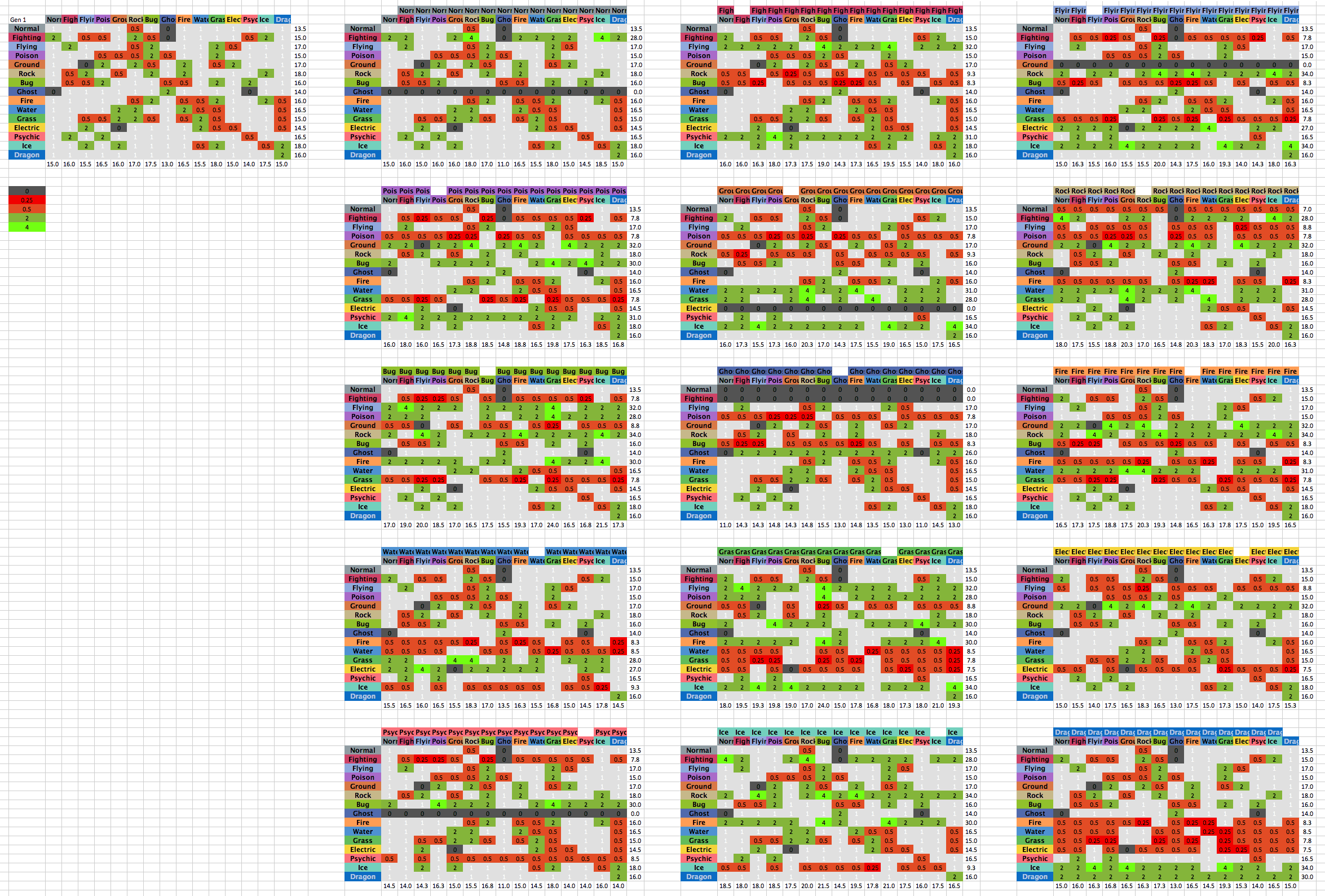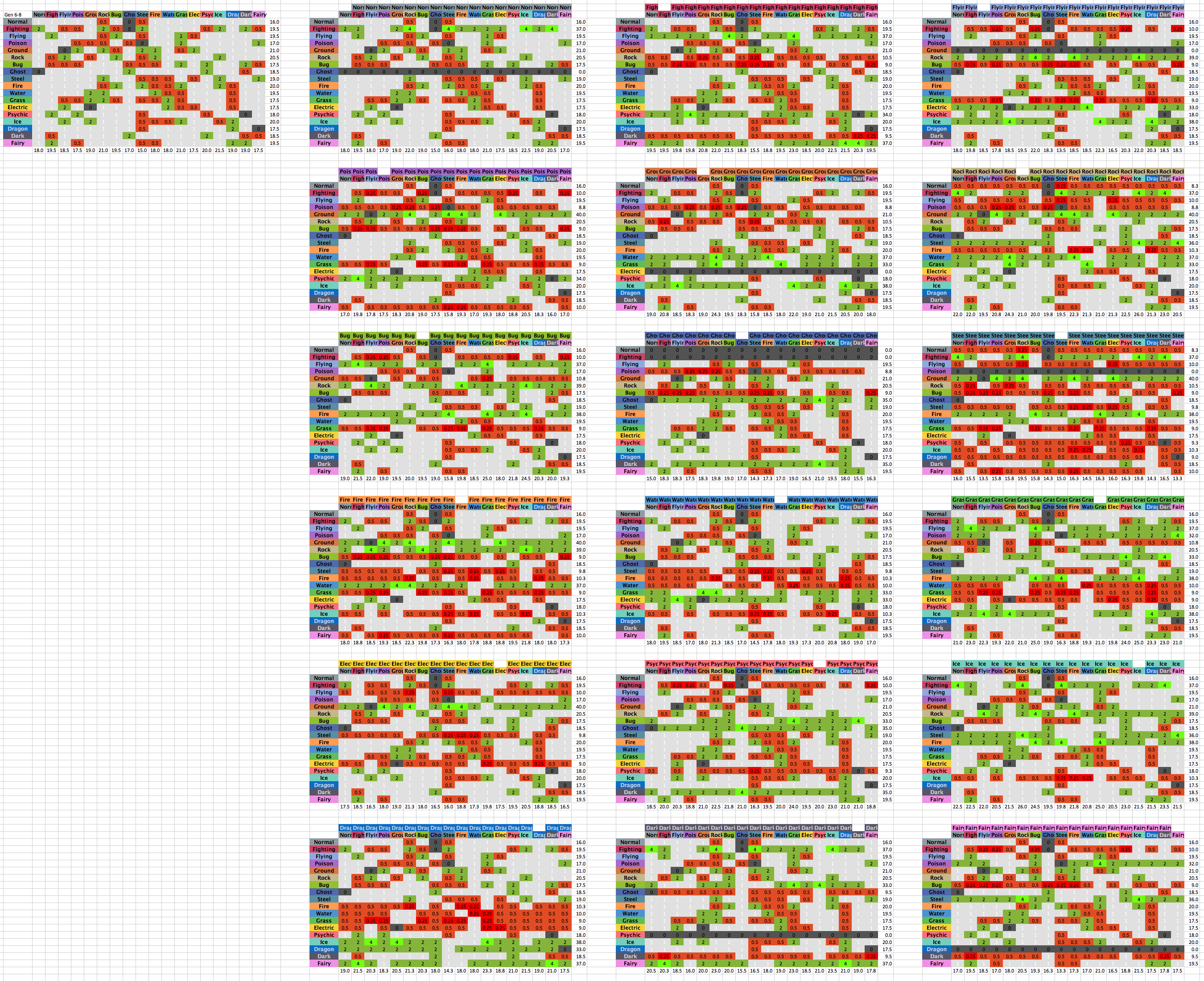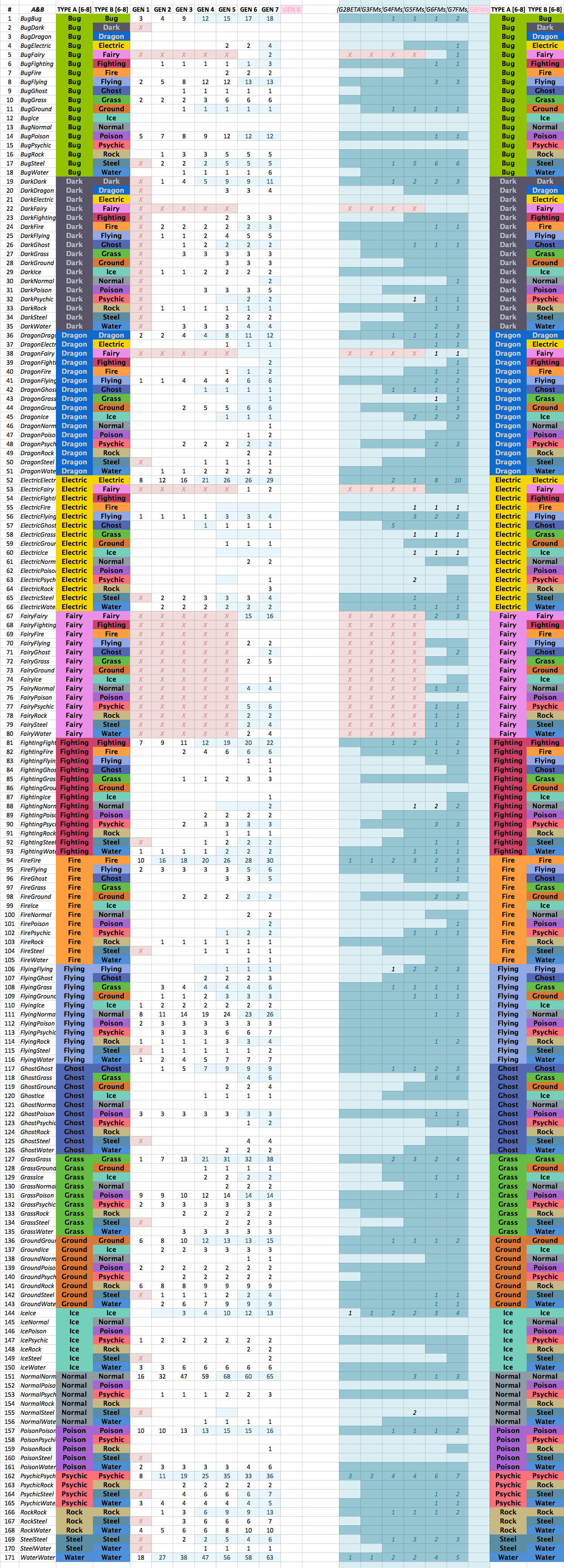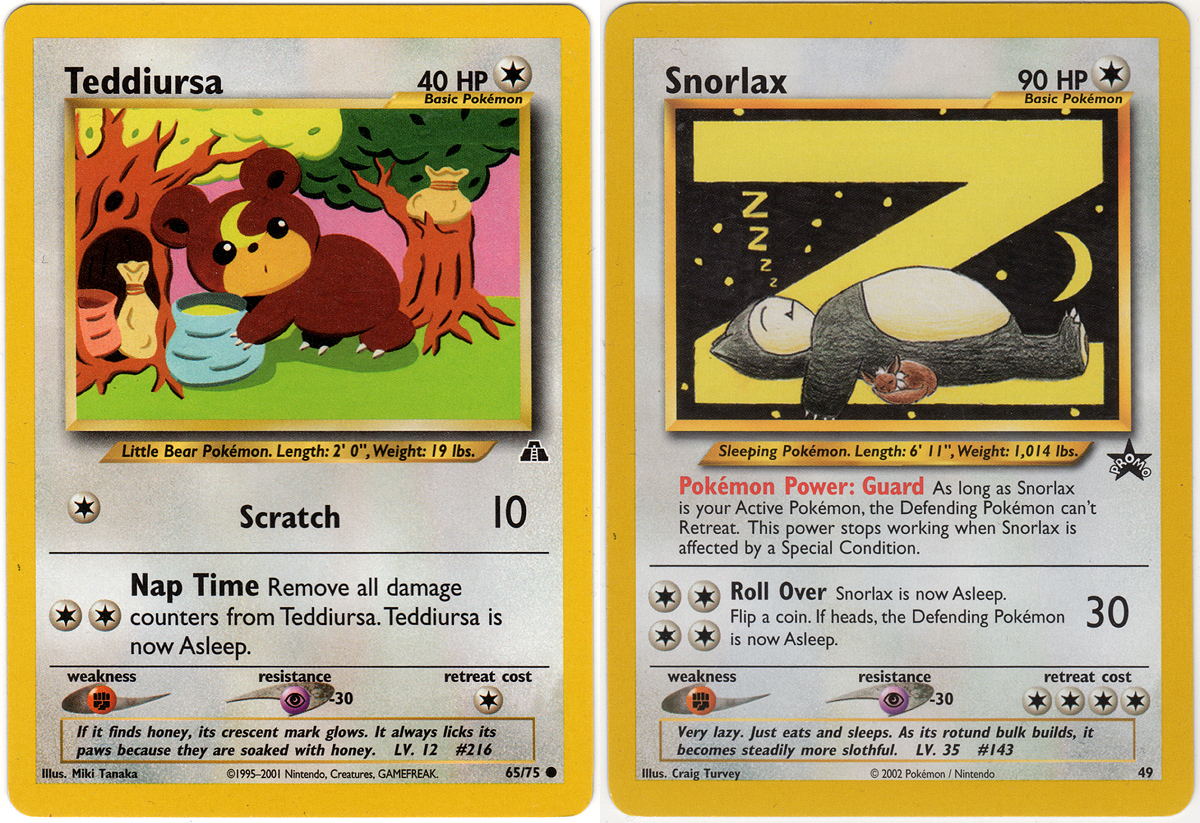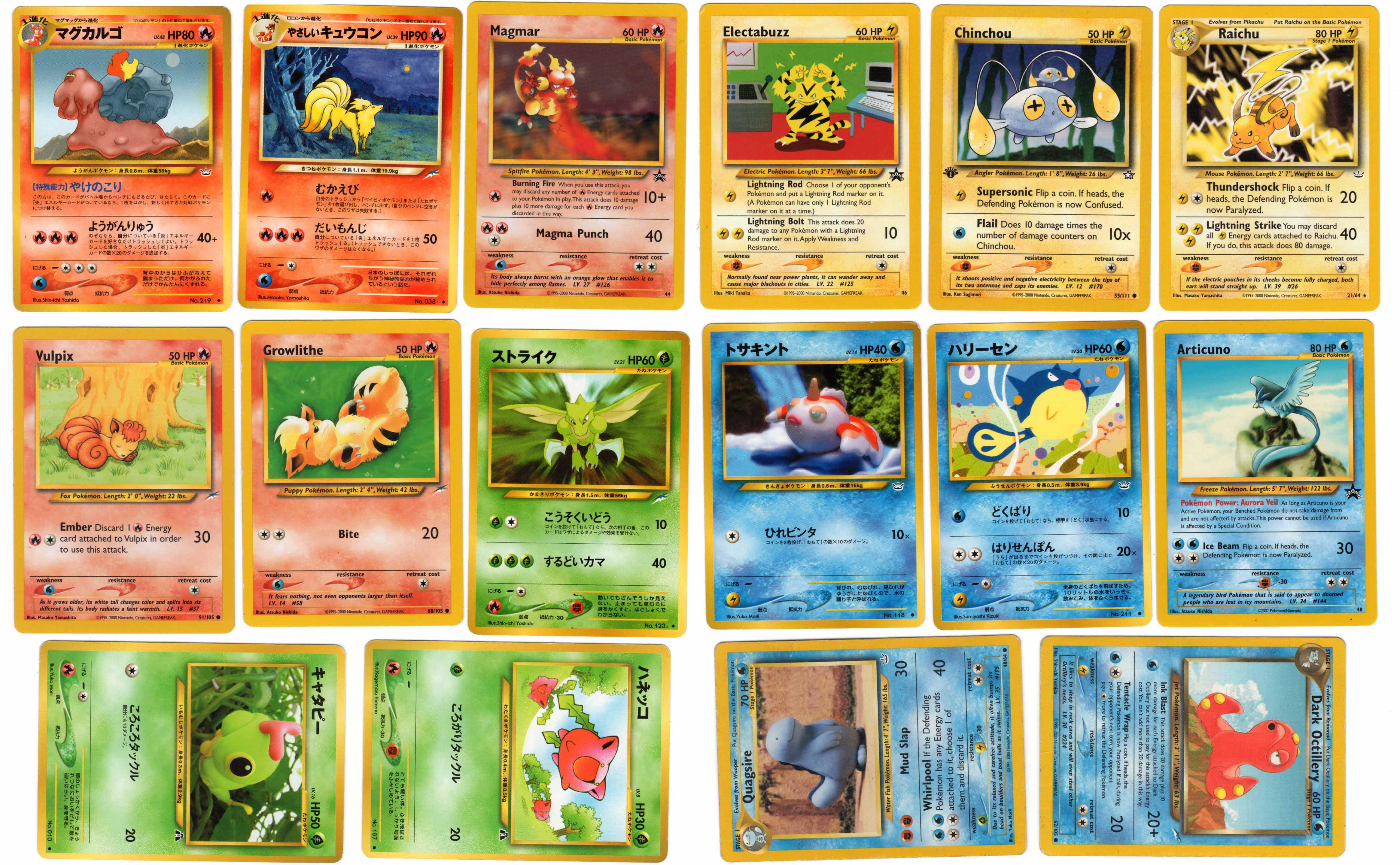The Actual News:
Sorry for not updating over the last couple days, but I’ve been busy with all sorts of things. Like, I was meaning to post this two days back, but I’m only now just getting to it. But it’ll be worth the wait!
Anyways, there are three things I’d like to cover in this post:
- A history of type colors — five generations of whatever color “Dragon” is!
- Type data for EVERY gen — finally: definitive proof that Caterpie is a terrible Pokémon
- Blanks for the GS Space World set are begun — but an 18-year-old surprise has stopped me in my tracks slightly
This update has something for everyone! Artists, gamers or fakers; I’m sure something in this post will tickle your pickle! … And by “pickle” I mean your brain, because I’m sure it’s quite pickled after some 10 years worth of sloshing it around in alcohol. (BTW, wanna do Jager shots later? 
 )
)
A history of type colors 
Since Gen 3—Pokémon Ruby & Sapphire—each Pokémon type was given a color to symbolize it and help make it stand out against the other types. The colors used were a bit plain, and some types (like Dragon and Poison) had two colors… but they worked.
Later as the games grew more sophisticated, the colors for the types grew and changed slightly… with actually the most significant color changes occurring in Gen 8 (Sword/Shield); I covered THOSE colors in the previous post.
Anyways, I was bored one night, so I went through each game and pulled the various colors that have been used to define it. The results are in the pixelized image just to the upper-right; I started with Gen 8 then worked backwards, with each type taking up two pixel rows, and each Gen in two pixel columns. I won’t even begin to explain what the colors actually come from—each game had different ways to utilize each color and shade—but you can trust that I did the most accurate job I could.
For the pièce de résistance, I took each color and blended them together, thus forming the most overall and average and succinct definition of that type. Those colors are in the right-most column in the graphic above, but I’ve reproduced those colors and their hex color codes below. I thought about doing the same for every other color, but I’m too lazy to do that, so you can just download the image and use the eye-dropper tool in Photoshop to grab it.
To wrap things up: I like doing this kind of stuff because it’s fun and I’m just curious to know what color totally summarizes that type. But more importantly, as an artist, knowing these colors definitely helps with my art, because it gives me a pallet to work with. You’ll definitely see some examples when I start drawing art for the GS Space World fake card set… but imagine a Ground-Water Pokémon drawn and colored using only the colors that were used for that type across 15 years of Pokémon games. I can’t wait to see what that could look like! 
| TYPE | COLOR | NOTES |
| Normal | #ACAD99 | |
| Fighting | #C45D4C | |
| Flying | #90AAD7 | |
| Poison | #B369AF | |
| Ground | #CEB250 | |
| Rock | #BAA85E | |
| Bug | #ACC23E | |
| Ghost | #816DB6 | Turns out to be too much like Dragon |
| Steel | #9FA9AF | |
| Fire | #E87A3D | |
| Water | #639CE4 | |
| Grass | #82C95B | |
| Electric | #E7C536 | |
| Psychic | #E96C95 | |
| Ice | #81CFD7 | |
| Dragon | #8572C8 | Too much like Ghost |
| Dark | #79726B | |
| Fairy | #E8B0EB |
Type data for EVERY gen
This section covers two different ideas, although both involve data I gathered about the types in Pokémon. The first involves type damage multiplier data across three periods of Pokémon games, and the other is about which types and type combinations were introduced during what generation, and which are left.
Now the type damage multiplier thing is something I covered before; in fact it’s probably one of the earliest features added to this version of the site. But if you need a reminder; back during Gen 5 and Pokémon Black & White, I made a little chart in Excel where I combined the damage multiplier data for two Pokémon types and then used that data to determine which type combinations were the most weak or most resistant to type-related damage, assuming everything else was equal.
- (Long story short, Ghost-Steel was the most resistant to attacks, while Ice-Rock was weakest to the most types.)
However, that data was only accurate for Gens 2-5, seeing as it included Dark and Steel type, but didn’t cover the Fairy-type that was added in Gen 6. Not to mention the various type damage readjustments. And so here it is; you can also click on them to get a more detailed look.
The changes between each Gen really isn’t THAT much, but it does change a few things between each gen… particularly which type combinations are the most resistant or weak to attacks.
Oh also, the numbers at the bottom and right-side of each chart box are the type multipliers added together in order to get a single number which represents that type’s quality. Smaller number is better; obviously a type which takes only 0.5x damage from all other types is better than a type where each type’s attacks to 2x damage. Knowing this, here’s some perspective about what would be good or bad numbers.
- GEN 1 — with 15 types, a score of 15 would be average, meaning that each type, on average, does 1x damage to that type. Anything lower is better, and higher is worse.
- GEN 2-5 — 17 types means 17 points is average
- GEN 6-8 — 18 types = 18 points
Now obviously 17 points in Gen 1 is technically worse than 17 points in Gen 6-8. So to get an idea of what the scores in one era would translate to in another, that data is in the charts below. These you’ll definitely need to click in order to see them.
Again, since different numbers mean slightly different qualities in different gens, the charts thus include four different columns in order to make point comparisons easier. The columns mean:
- RAW — the actual data, divided by the number of types in that gen, thus generating a percentage.
- 15 — the percentage multiplied by 15
- 17 — multiplied by 17
- 18 — multiplied by 49.3 … …ok 18.
OK so what are the best and worst types for Gen 1 and Gen 6-8?
- GEN 1
- Best = Ghost-Normal and Ghost-Psychic (tied); however technically Psychic- and Electric-Flying types are the most resistant, at least of the types which actually appear in the game. Color me shocked.
- Worst = Bug-Grass (by a WIDE margin) … see? How you have actual proof that Caterpie is awful!
- GEN 6-8
- Best = Fairy-Steel; so I guess that makes Mawile a pain in the ass to KO, huh?
- Worst = Ice-Rock as well; thus making Aurorus the weakest Pokémon… well, type-wise.
It’s worth pointing out that the Ghost-Steel type from Gens 2-5 is overall THE strongest Pokémon type across all three type eras—scoring a 69.12% resistance versus Gen 1’s Ghost-Normal/Psychic’s 73.33% and 73.61% for Gen 6-8’s Fairy-Steel—while Gen 1’s Bug-Grass type is the ABSOLUTE WORST type combination—scoring 160% versus Ice-Rock’s Ice-Rock 147.06% during Gen 2-5 and 144.44 in Gens 6-8.
…
Jeez, and I still haven’t gotten to the last chart! OK, so let’s just fast forward through this part.
Every gen has a set of Pokémon of a certain type. This chard covers each generation and each type that was in it, as well as each type that WASN’T in it. Like everything else, you can click on it to get a zoomed in view.
One thing that I did with this was keep the number of regular Pokémon types separate from Pokémon with formes. So the values on the left are the number of normal Pokémon with those types; these values also regional forms (Alolan Meowth, etc) which can be found in the wild and/or evolve normally from a normal Pokémon and are therefore considered just as official. Meanwhile, the values on the right are the number of special Pokémon with those types, such as the aforementioned formes (which I consider different from regional types as they’re either temporary or conditional), as well as PokéWood “Stars” which had their own unique typing. I’ve even included Beta Pokémon (such as ones from the Space World 1997 demo)!
Because of this two column layout, I’ve shaded the left cells based on what’s in the right side, and vice versa. This helps you determine if the right-sided forme types are something that already existed, or is instead something that is TRULY new and unique, relative to their normal counterpart. For example, a Dark/Psychic-type Pokémon actually first appeared as a “PokéWood Star” in Gen 5 before appearing as a “normal” Pokémon in Gen 6. Meanwhile, you can see Rotom’s various formes (Electric/Fire, /Grass, and /Ice) in the right-side column as well, and how no official Pokémon had those types between Gens 5-7.
- (Side note: I did not include Gen 8’s Pokémon because I hadn’t beaten it when I originally worked on this, and I didn’t want to spoil anything yet. But hope to update this list soon.)
There we are!
Blanks for the GS Space World set are begun
And now for what you’ve been waiting for… the first real update to the new fake card set with some new blanks! … I mean, that IS why you’re here, right?
Anyways, first off, lemme share with you a couple pictures. Because I want to make the best looking blanks possible, or at least the best I’ve ever made, I’m planning on working at a much larger level than I’ve EVER worked in before. To get an idea of the scale I’m working at…
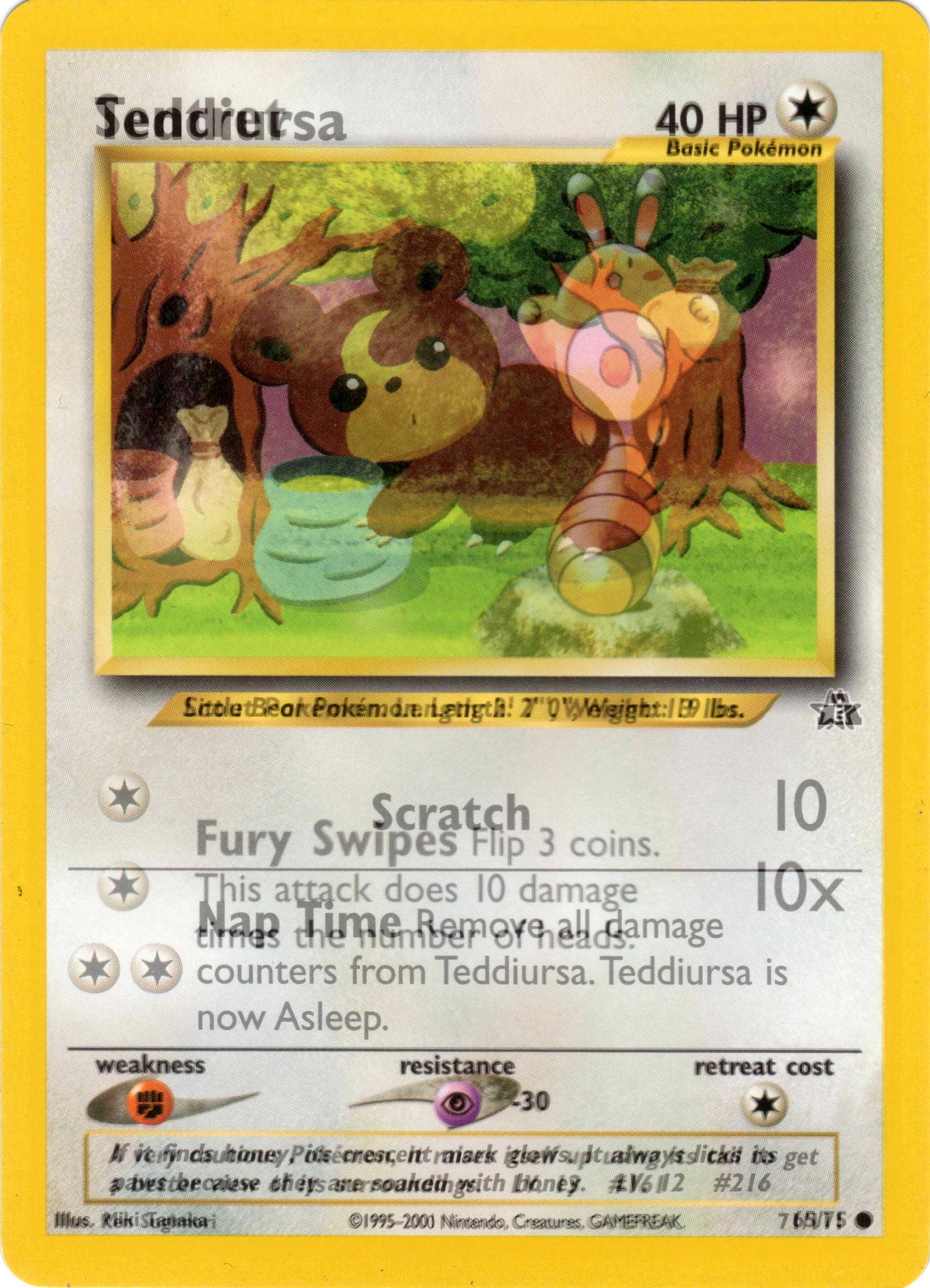 |
||||
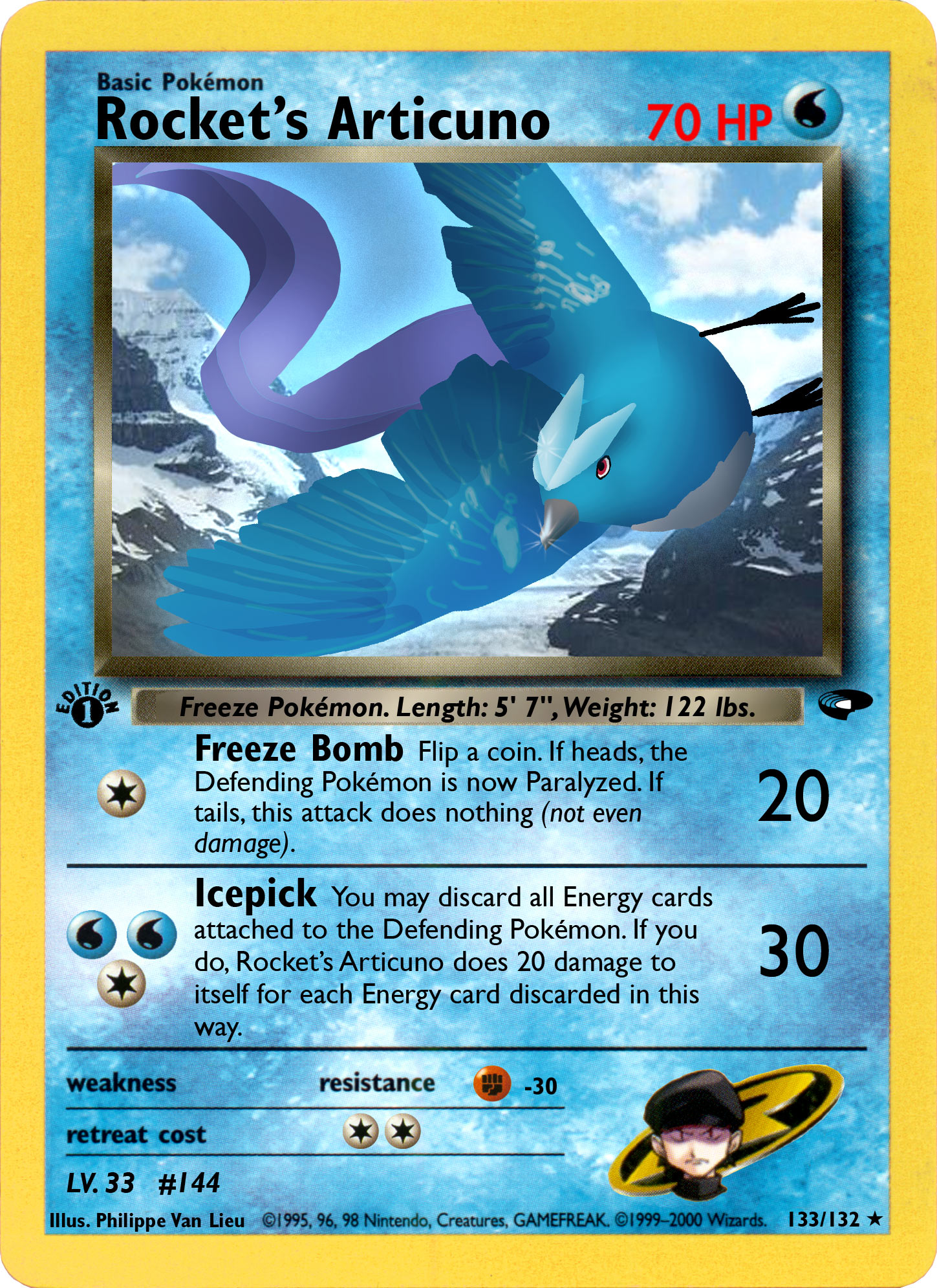 |
||||
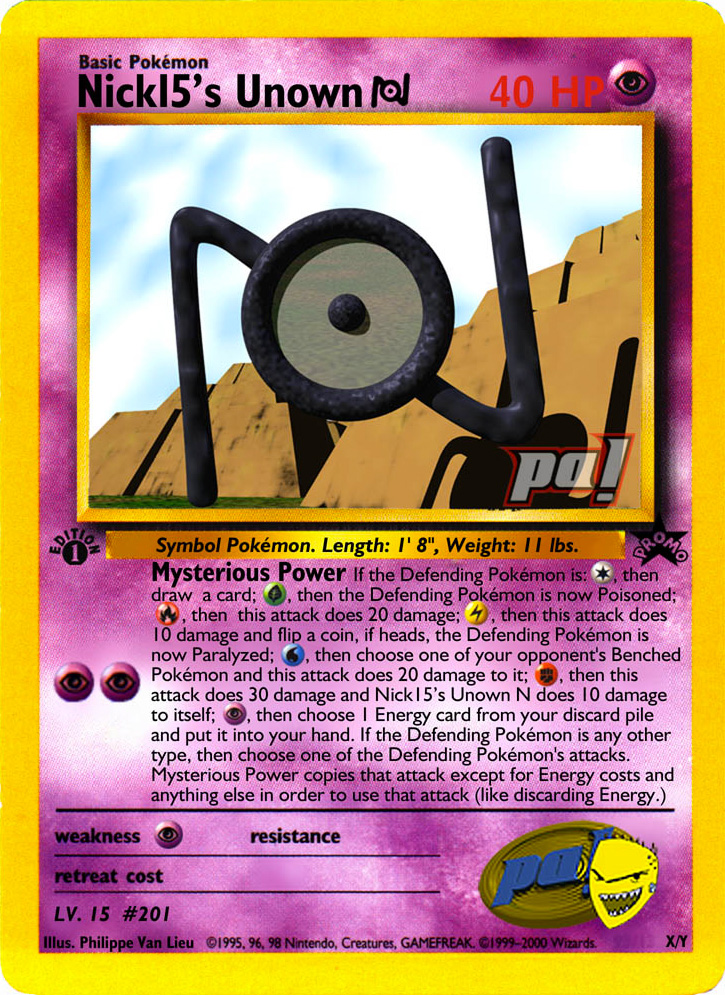 |
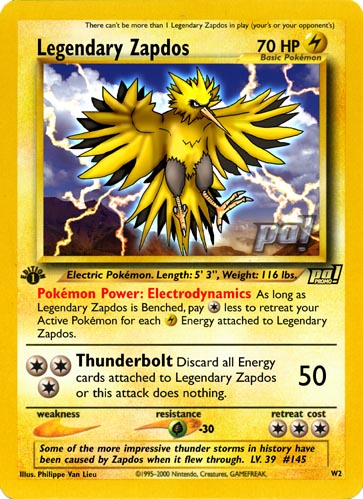 |
|||
All four of these cards are scaled exactly as intended. But what are they?
- The Rocket’s Articuno is the actual scale I worked in when I created my last series of blanks, as well as the fakes I made for Mayakashi Edition. This was four times (2 x 2) as large as….
- The Nick15’s Unown N card was the scale that I worked at when I remade the very first blanks I did. As you can see, it was also four times as large as….
- The Legendary Zapdos card was the scale that I saved my finalized fake cards to be posted on the site. The fact that my working scale was 16x larger than the exported scale allowed me to pack in a lot of details which made it look all the more realistic when shrunk down to that size.
- Finally, the Sentret Teddiursa card is at the size I’ll be working at; 4x larger than the largest scale I used previously, and thus 64x the final export size. Whoo!
Like with everything, you can click/tap on the pictures and see them in their full glory. That’s just a small idea of the kinds of things I do for faking.
….
As for other things I do for faking… while going through my scans of various Neo-era cards in order to work out what looks good or not, I stumbled upon something about these card designs that I NEVER NOTICED in until today. Like, I went 18 years before realizing that these cards were designed like this.
Here, take a look at these two Neo-era cards. Maybe you already saw what I only just noticed, or maybe not. But either way, do you see it?
It’s subtle enough that I certainly didn’t see it until now, but check it out: the Neo-era designs are slightly different! The design used between Neo Genesis to Neo Revelations is on the left, while Neo Destiny is on the right; for the sake of consistency, let’s call them “NeoA” and “NeoB” respectively. A quick rundown of the design differences include:
- NeoB’s Pokédex info box has a shadow underneath it, while NeoA doesn’t. It’s also slightly taller.
- Neo A’s picture box has a deeper shadow than NeoB.
- NeoB’s energy symbols are slightly lighter… almost “smoother”.
- NeoB’s picture box has a slightly different gradient to it; the easiest difference to notice is how NeoB’s frame has a reddish hint towards the top of its right side, which NeoA’s frame doesn’t have.
There are other itty bitty differences which my speshul eyes can see, but I started to think about what I should do. I guess the easy thing to do would just stick with NeoA and be done with it… but then I’d have to not use a ton of cards I scanned. And I scanned a ton of cards.
So what I’m thinking is… since this fake card set is supposed to cover a beta version of GS, which happens to also be a slightly different version of GS with slightly different Pokémon in a very different timeline and region… maybe I’ll make these Neo blanks unlike any single existing Neo set and instead do something that is a sort of mix between NeoA, NeoB, and the Japanese Neo style. This way I’ll have a Neo-style blank which people can tell is definitely from a Neo-era set… but just like the Space World demo, it’ll be slightly, albeit clearly, different. It’ll be like they’re taking a peek into an alternate timeline, one where we got the SpaceWorld version of Pokémon Gold/Silver, and therefore got the SpaceWorld version of the Pokémon TCG Neo set.
Hell, maybe I won’t call it “Neo” either! … Well, maybe I will. Sorta. I dunno.
Point is, this happy accident of not realizing that there were two different Neo card designs got me to consider making a slightly different Neo blank which in turn fits perfectly with the theme of the SpaceWorld Beta version.
…
OK, I’m done talking now. I command that you finish reading this article. You WILL comply! Seriously! Why haven’t you stopped reading this article? You are violating a direct order!!

